check engine GMC SAVANA 1998 Owner's Guide
[x] Cancel search | Manufacturer: GMC, Model Year: 1998, Model line: SAVANA, Model: GMC SAVANA 1998Pages: 388, PDF Size: 20.04 MB
Page 265 of 388
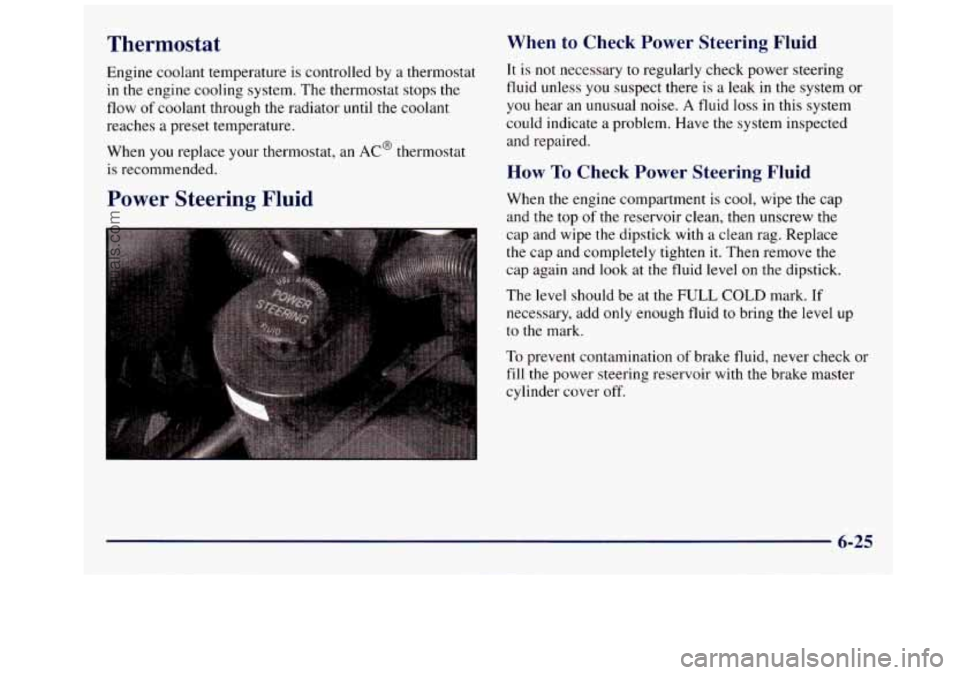
Thermostat
Engine coolant temperature is controlled by a thermostat
in the engine cooling system. The thermostat stops the
flow
of coolant through the radiator until the coolant
reaches
a preset temperature.
When
you replace your thermostat, an AC@ thermostat
is recommended.
Power Steering Fluid
When to Check Power Steering Fluid
It is not necessary to regularly check power steering
fluid unless you suspect there
is a leak in the system or
you hear an unusual noise. A fluid loss in this system
could indicate
a problem. Have the system inspected
and repaired.
How To Check Power Steering Fluid
When the engine compartment is cool, wipe the cap
and the top
of the reservoir clean, then unscrew the
cap and wipe the dipstick with a clean rag. Replace
the cap and completely tighten it. Then remove the
cap again and look at the fluid level on the dipstick.
The level should be at the
FULL COLD mark. If
necessary, add only enough fluid to bring the level up
to the mark.
To prevent contamination of brake fluid, never check or
fill the power steering reservoir with the brake master
cylinder cover
off.
6-25
ProCarManuals.com
Page 268 of 388
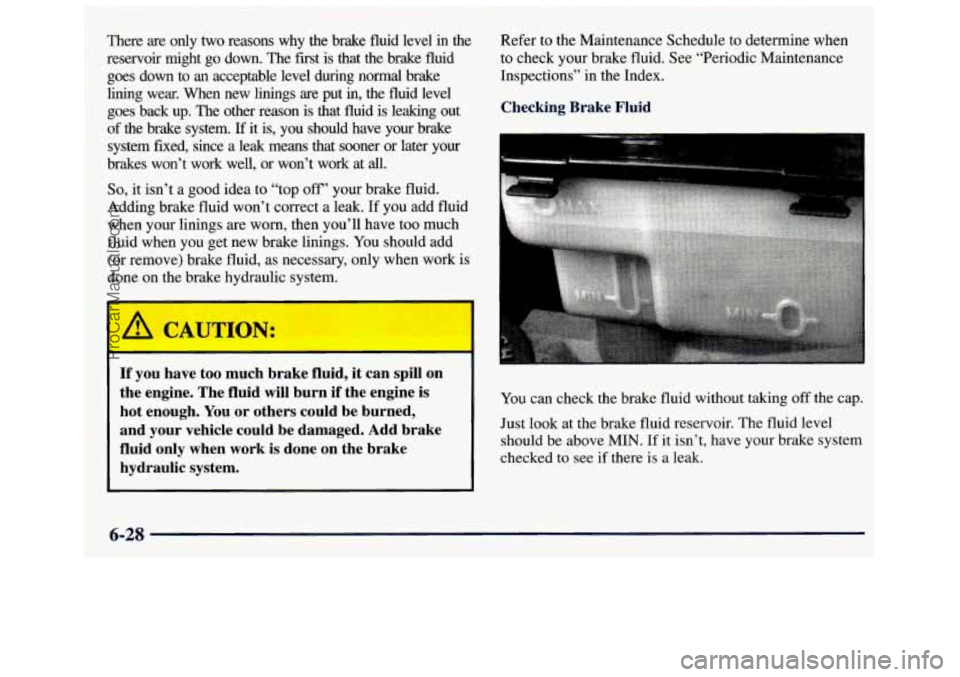
There are only two reasons why the brake fluid level in the
reservoir might go down. The first is that the brake fluid
goes down to
an acceptable level during normal brake
lining wear. When new linings are put in, the fluid level
goes back up. The other reason is that fluid is leaking out
of the brake system. If it is, you should have your brake
system fixed, since a leak means that sooner or later your
brakes won’t work well, or won’t work at
all.
So, it isn’t a good idea to “top off’ your brake fluid.
Adding brake fluid won’t correct a leak. If
you add fluid
when your linings are worn, then you’ll have too much
fluid when you get new brake linings. You should add
(or remove) brake fluid, as necessary, only when work is
done on the brake hydraulic system.
If you have too much brake fluid, it can spill on
the engine. The fluid
will burn if the engine is
hot enough. You or others could be burned,
and your vehicle could be damaged. Add brake
fluid only when work is done on the brake
I hydraulic system.
Refer to the Maintenance Schedule to determine when
to check your brake fluid. See “Periodic Maintenance
Inspections” in the Index.
Checking Brake Fluid
You can check the brake fluid without taking off the cap.
Just
look at the brake fluid reservoir. The fluid level
should be above MIN. If it isn’t, have your brake system
checked to
see if there is a leak.
6-28
ProCarManuals.com
Page 308 of 388
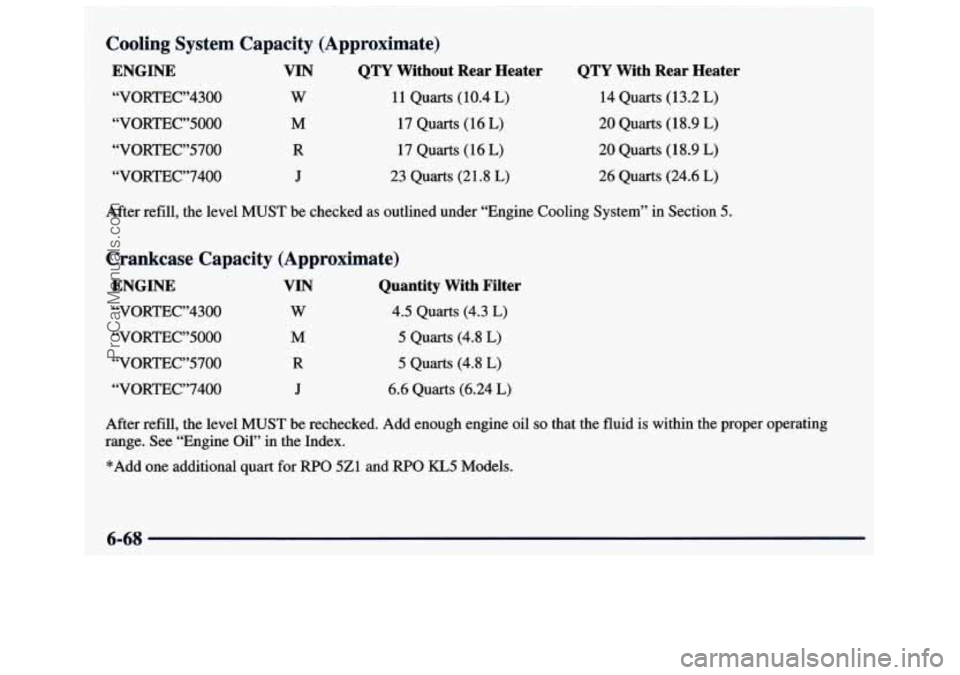
Cooling System Capacity (Approximate)
ENGINE VIN QTY Without Rear Heater
“VORTEC”4300 W 11 Quarts (10.4 L)
“VORTEC”5000 M 17 Quarts (16 L)
“VORTEC”5700 R 17 Quarts (16 L)
“VORTEC”7400 J 23 Quarts (21.8 L)
QTY With Rear Heater
14 Quarts (13.2 L)
20 Quarts (18.9 L)
20 Quarts (18.9 L)
26 Quarts (24.6 L)
After refill, the level MUST be checked as outlined under “Engine Cooling System” in Section 5.
Crankcase Capacity (Approximate)
ENGINE VIN Quantity With Filter
“VORTEC”4300 W 4.5 Quarts (4.3 L)
“VORTEC”5000 M 5 Quarts (4.8 L)
“VORTEC”5700 R 5 Quarts (4.8 L)
“VORTEC”7400 J 6.6 Quarts (6.24 L)
After refill, the level MUST be rechecked. Add enough engine oil so that the fluid is within the proper operating
range. See “Engine Oil” in the Index.
*Add one additional quart for
RPO 5Z1 and RPO KL5 Models.
ProCarManuals.com
Page 316 of 388
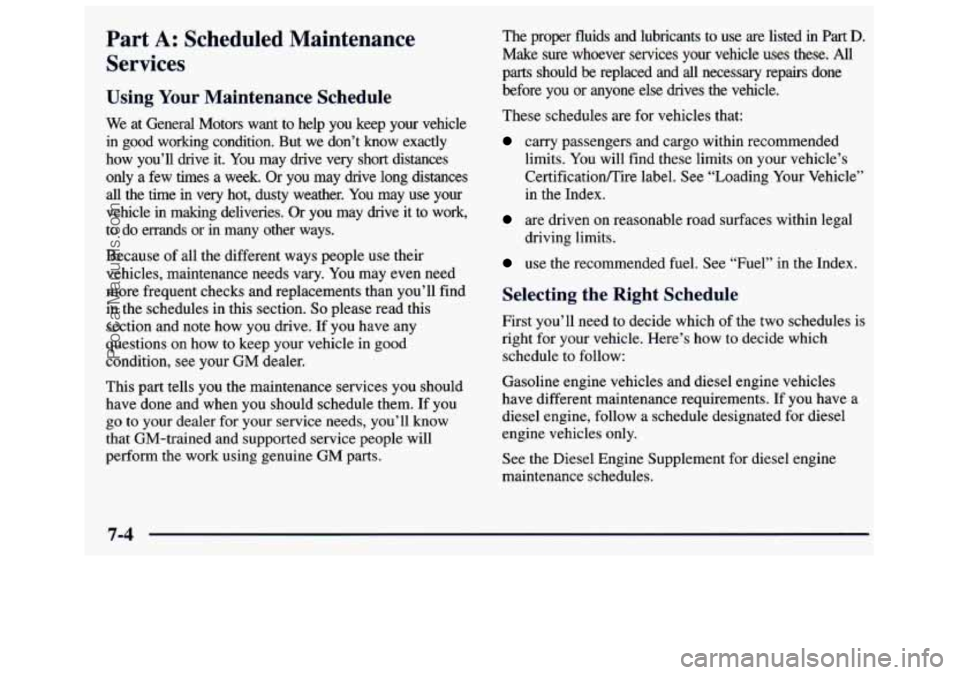
Part A: Scheduled Maintenance
Servk - s
Using Your Maintenance Schedule
We at General Motors want to help you keep your vehicle
in good working condition. But we don’t know exactly
how you’ll drive it. You may drive very short distances
only a few times a week.
Or you may drive long distances
all the time in very hot, dusty weather. You may use your
vehicle
in making deliveries. Or you may drive it to work,
to do errands or
in many other ways.
Because of all the different
ways people use their
vehicles, maintenance needs
vary. You may even need
more frequent checks and replacements than you’ll find
in the schedules in this section.
So please read this
section and note how you drive. If you have any
questions
on how to keep your vehicle in good
condition, see your
GM dealer.
This part tells you the maintenance services you should
have done and when you should schedule them. If you
go to your dealer for your service needs, you’ll know
that GM-trained and supported service people will
perform the work using genuine GM
parts.
The proper fluids and lubricants to use are listed in Part D.
Make sure whoever services your vehicle uses these. All
parts should be replaced
and all necessary repairs done
before you or anyone else
drives the vehicle.
These schedules are for vehicles that:
carry passengers and cargo within recommended
limits. You will find these limits on your vehicle’s
Certificationflire label. See “Loading Your Vehicle’’
in the Index.
are driven on reasonable road surfaces within legal
driving limits.
use the recommended fuel. See “Fuel” in the Index.
Selecting the Right Schedule
First you’ll need to decide which of the two schedules is
right for your vehicle. Here’s how
to decide which
schedule to follow:
Gasoline engine vehicles
and diesel engine vehicles
have different maintenance requirements. If you have
a
diesel engine, follow a schedule designated for diesel
engine vehicles only.
See the Diesel Engine Supplement for diesel engine
maintenance schedules.
7-4
ProCarManuals.com
Page 320 of 388
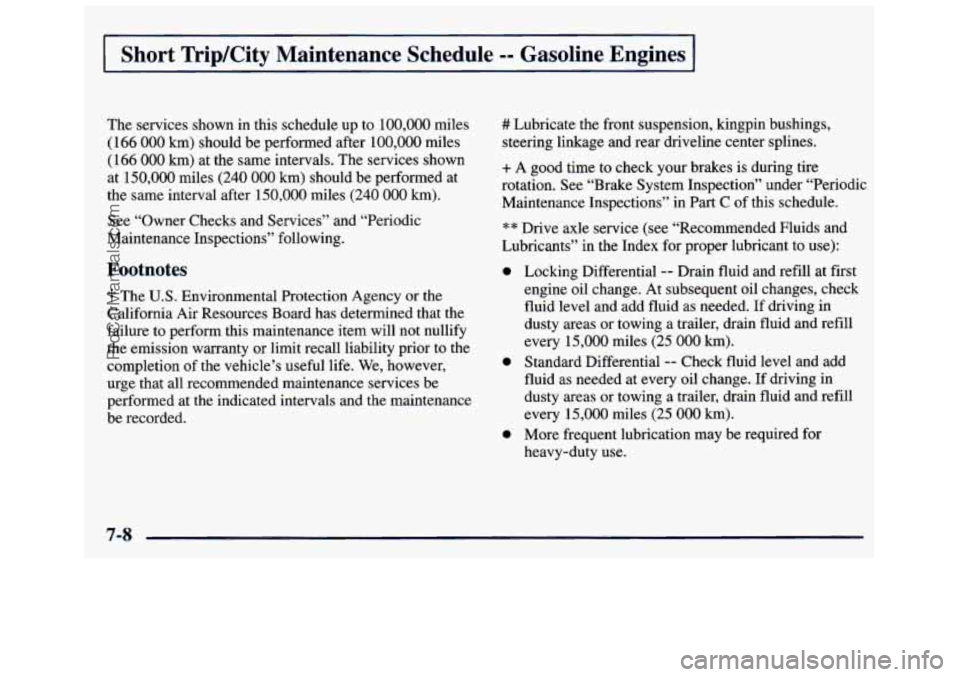
Short ”kip/City Maintenance Schedule -- Gasoline Engines
The services shown in this schedule up to 100,000 miles
(166
000 km) should be performed after 100,000 miles
(166
000 km) at the same intervals. The services shown
at
150,000 miles (240 000 km) should be performed at
the same interval after
150,000 miles (240 000 km).
See “Owner Checks and Services” and “Periodic
Maintenance Inspections” following.
Footnotes
The U.S. Environmental Protection Agency or the
California Air Resources Board has determined that the
failure to perform this maintenance item will not nullify
the emission warranty or limit recall liability prior to the
completion of the vehicle’s useful life. We, however,
urge that all recommended maintenance services be
performed at the indicated intervals and the maintenance
be recorded.
# Lubricate the front suspension, kingpin bushings,
steering linkage and rear driveline center splines.
+ A good time to check your brakes is during tire
rotation. See “Brake System Inspection” under “Periodic
Maintenance Inspections” in Part
C of this schedule.
** Drive axle service (see “Recommended Fluids and
Lubricants” in the Index for proper lubricant to use):
e
e
e
Locking Differential -- Drain fluid and refill at first
engine oil change. At subsequent oil changes, check
fluid level and add fluid as needed.
If driving in
dusty areas
or towing a trailer, drain fluid and refill
every 15,000 miles
(25 000 km).
Standard Differential -- Check fluid level and add
fluid as needed at every oil change.
If driving in
dusty areas or towing a trailer, drain fluid and refill
every
15,000 miles (25 000 km).
More frequent lubrication may be required for
heavy-duty use.
7-8
ProCarManuals.com
Page 321 of 388
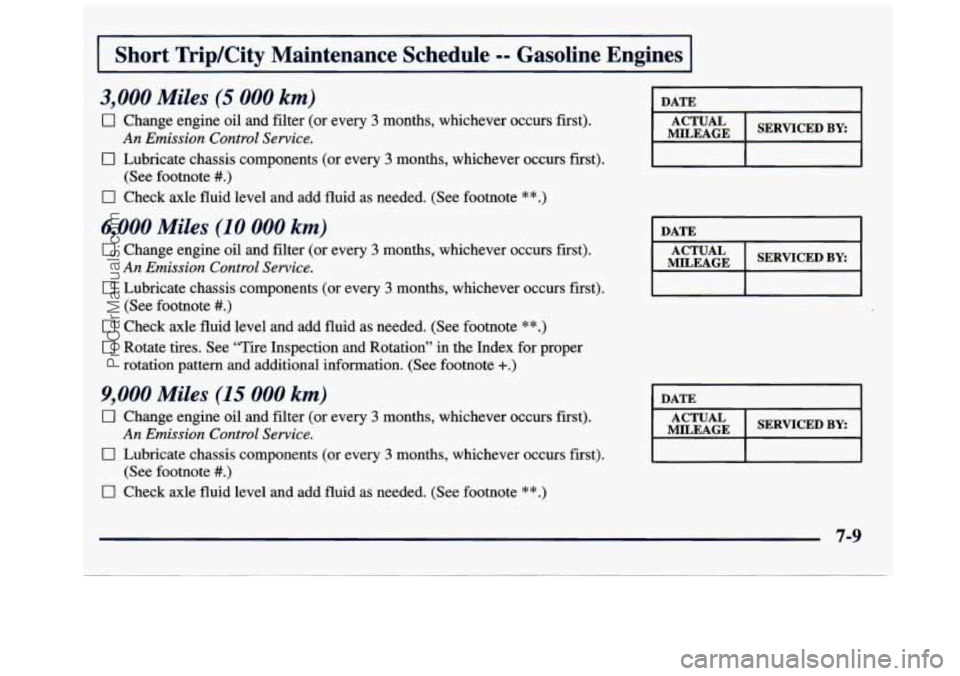
1
I Short Trip/Cits Maintenance Schedule -- Gasoline Engines I
3,000 Miles (5 000 km)
0 Change engine oil and filter (or every 3 months, whichever occurs first).
0 Lubricate chassis components (or every 3 months, whichever occws first).
0 Check axle fluid level and add fluid as needed. (See footnote **.)
An Emission Control Service.
(See footnote #.)
6,000 Miles (10 000 km)
0 Change engine oil and filter (or every 3 months, whichever occurs fiist).
0 Lubricate chassis components (or every 3 months, whichever occurs first).
0 Check axle fluid level and add fluid as needed. (See footnote **.)
Cl Rotate tires. See “Tire Inspection and Rotation” in the Index for proper
rotation pattern and additional information. (See footnote
+.)
An Emission Control Service.
(See footnote #.)
9,000 Miles (15 000 km)
0 Change engine oil and filter (or every 3 months, whichever occurs first).
0 Lubricate chassis components (or every 3 months, whichever occurs fiist).
0 Check axle fluid level and add fluid as needed. (See footnote **.)
An Emission Control Service.
(See footnote #.)
DATE I
DATE I
DATE I
7-9
ProCarManuals.com
Page 322 of 388
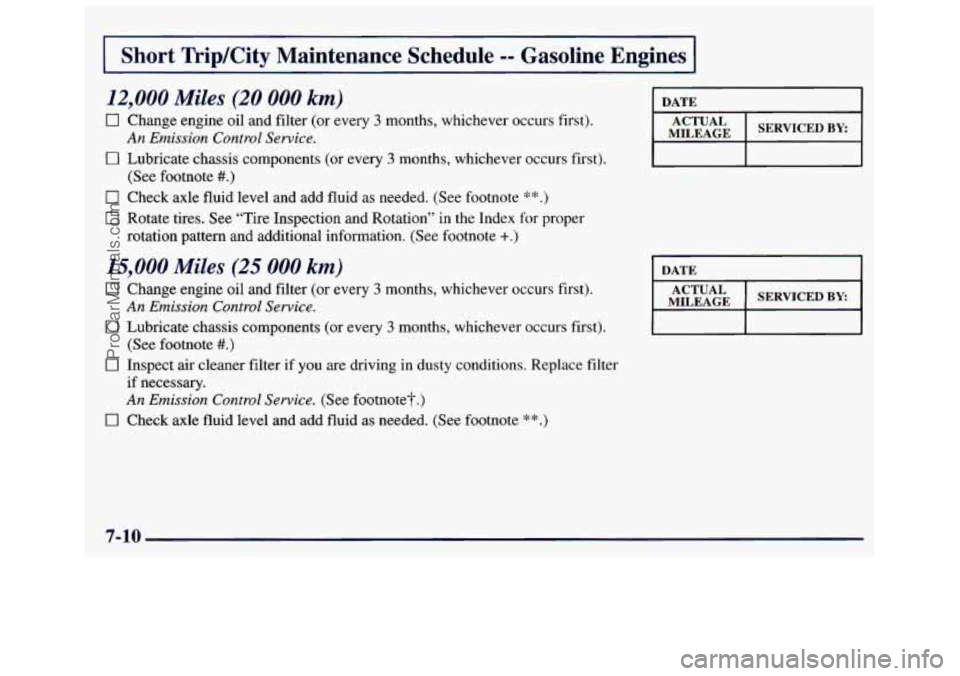
I Short TripKity Maintenance Schedule -- Gasoline Engines I
12,000 Miles (20 000 km)
0 Change engine oil and filter (or every 3 months, whichever occurs first).
0 Lubricate chassis components (or every 3 months, whichever occurs first).
0 Check axle fluid level and add fluid as needed. (See footnote **.)
0 Rotate tires. See “Tire Inspection and Rotation” in the Index for proper
rotation pattern and additional information. (See footnote
+.)
An Emission Control Service.
(See footnote #.)
15,000 Miles (25 000 km)
0 Change engine oil and filter (or every 3 months, whichever occurs first).
An Emission Control Service.
0 Lubricate chassis components (or every 3 months, whichever occurs first).
0 Inspect air cleaner filter if you are driving in dusty conditions. Replace filter
(See
footnote
#.)
if necessary.
An Emission Control Service. (See footnote?.)
0 Check axle fluid level and add fluid as needed. (See footnote **.)
I DATE I
I MILEAGE ACTUAL I SERVICEDBY I
DATE I
7-10
ProCarManuals.com
Page 323 of 388
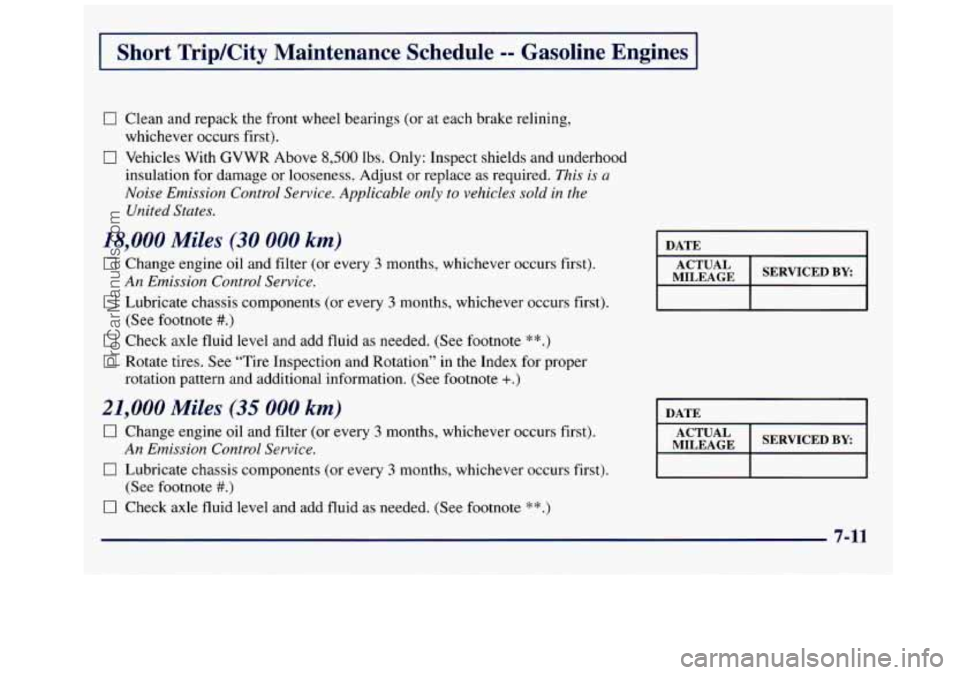
I Short Trip/City Maintenance Schedule -- Gasoline Engines I
17 Clean and repack the front wheel bearings (or at each brake relining,
whichever occurs first).
0 Vehicles With GVWR Above 8,500 lbs. Only: Inspect shields and underhood
insulation for damage or looseness. Adjust or replace as required.
This is a
Noise Emission Control Service. Applicable only to vehicles sold in the
United States.
18,000 Miles (30 000 km)
0 Change engine oil and filter (or every 3 months, whichever occurs first).
0 Lubricate chassis components (or every 3 months, whichever occurs first).
0 Check axle fluid level and add fluid as needed. (See footnote **.)
0 Rotate tires. See “Tire Inspection and Rotation” in the Index for proper
rotation pattern and additional information. (See footnote
+.)
An Emission Control Service.
(See footnote #.)
21,000 Miles (35 000 km)
0 Change engine oil and filter (or every 3 months, whichever occurs first).
0 Lubricate chassis components (or every 3 months, whichever occurs first).
0 Check axle fluid level and add fluid as needed. (See footnote **.)
An Emission Control Service.
(See footnote #.)
I DATE I
MILEAGE ACTUAL I SERVICED BY:
DATE I
MILEAGE ACTUAL I SERVICEDBY: I
7-11
ProCarManuals.com
Page 324 of 388
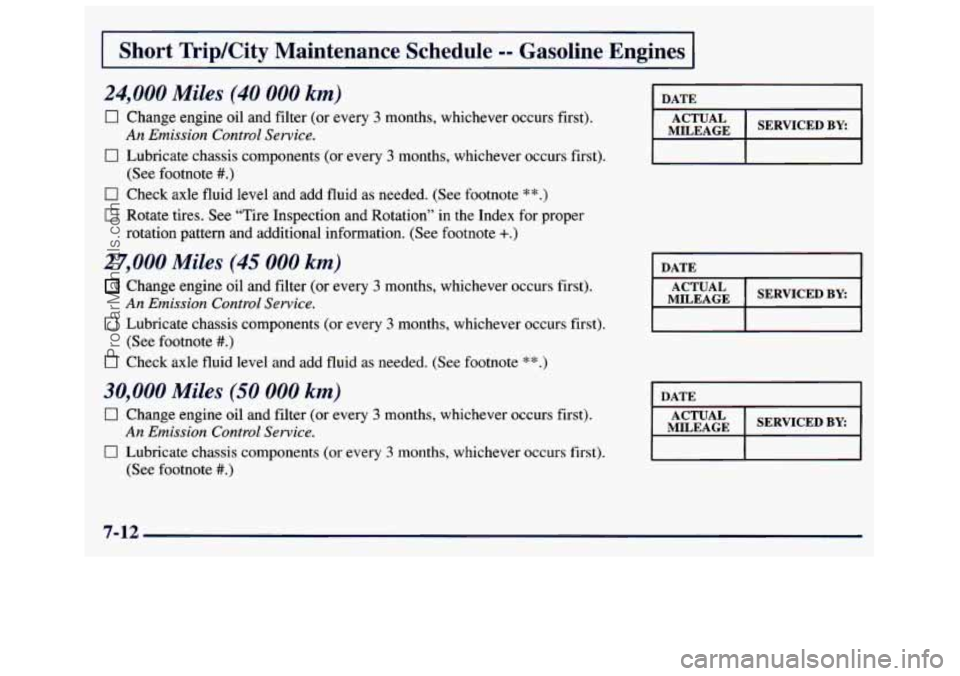
I Short Trip/City Maintenance Schedule -- Gasoline Engines I
24,000 Miles (40 000 km)
0 Change engine oil and filter (or every 3 months, whichever occurs first).
An Emission Control Service.
0 Lubricate chassis components (or every 3 months, whichever occurs first).
0 Check axle fluid level and add fluid as needed. (See footnote **.)
0 Rotate tires. See “Tire Inspection and Rotation” in the Index for proper
rotation pattern and additional information. (See footnote
+.)
(See footnote #.)
27,000 Miles (45 000 km)
Change engine oil and filter (or every 3 months, whichever occurs first).
0 Lubricate chassis components (or every 3 months, whichever occurs first).
0 Check axle fluid level and add fluid as needed. (See footnote **.)
An Emission Control Service.
(See footnote #.)
30,000 Miles (50 000 km)
0 Change engine oil and filter (or every 3 months, whichever occurs first).
0 Lubricate chassis components (or every 3 months, whichever occurs first).
An Emission Control Service.
(See footnote #.)
I DATE
MILEAGE
DATE I
MILEAGE
DATE 1
ACTUAL
7-12
ProCarManuals.com
Page 325 of 388
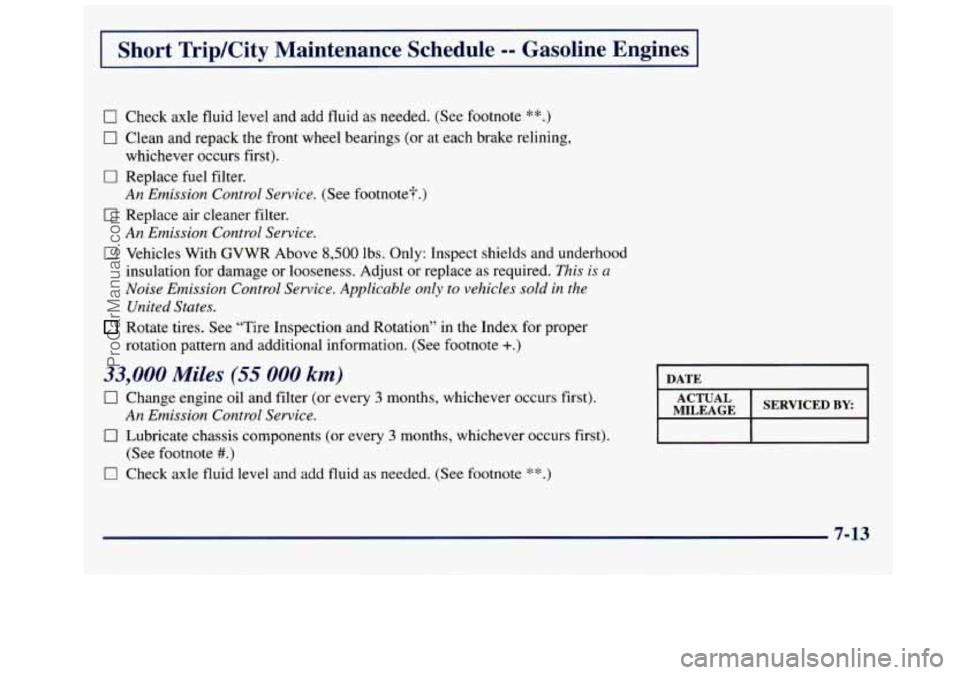
I Short TripKity Maintenance Schedule -- Gasoline Engines I
0 Check axle fluid level and add fluid as needed. (See footnote **.)
0 Clean and repack the front wheel bearings (or at each brake relining,
whichever occurs first).
0 Replace fuel filter.
An Emission Control Service. (See footnote?.)
0 Replace air cleaner filter.
An Emission Control Service.
0 Vehicles With GVWR Above 8,500 lbs. Only: Inspect shields and underhood
insulation for damage or looseness. Adjust or replace as required.
This is a
Noise Emission Control Service. Applicable
only to vehicles sold in the
United States.
Rotate tires. See “Tire Inspection and Rotation” in the Index for proper
rotation pattern and additional information. (See footnote
+.)
33,000 Miles (55 000 km)
0 Change engine oil and filter (or every 3 months, whichever occurs first).
An Emission Control Service.
0 Lubricate chassis components (or every 3 months, whichever occurs first).
0 Check axle fluid level and add fluid as needed. (See footnote **.)
(See footnote #.)
I DATE I
MILEAGE
7-13
ProCarManuals.com